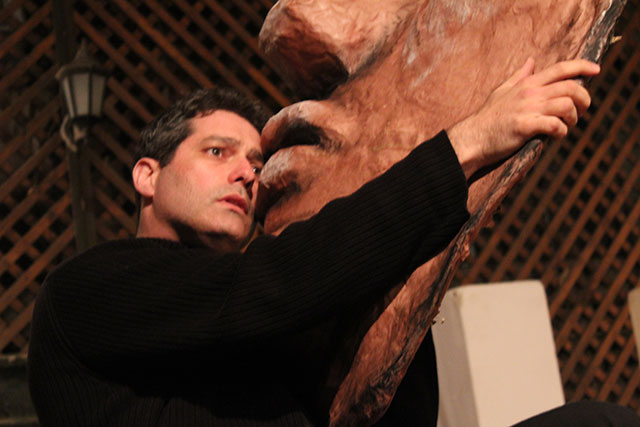
L.M. Bogad’s artful activism blends the strategies of civil disobedience with heaping doses of Harpo Marx. As a professor and “tactical performer, Bogad says he is committed to “speaking mirth to power.” In his long career he has staged outrageous theatrical spectacles to skewer governments, corporations and power brokers of all sorts. Bogad has worked with the Yes Men and with unions and human rights groups on picket lines and occupations around the world. He helped to create and train the spectacular Clandestine Insurgent Rebel Clown Army (CIRCA) and to make the street theater organization known as Billionaires for Bush — which calls for “Government of, by, and for the Corporations” — a fixture at the protests that shadowed George W. Bush’s time as president. All of this “serious play” is informed and inspired by constant research into the long history of creative resistance.
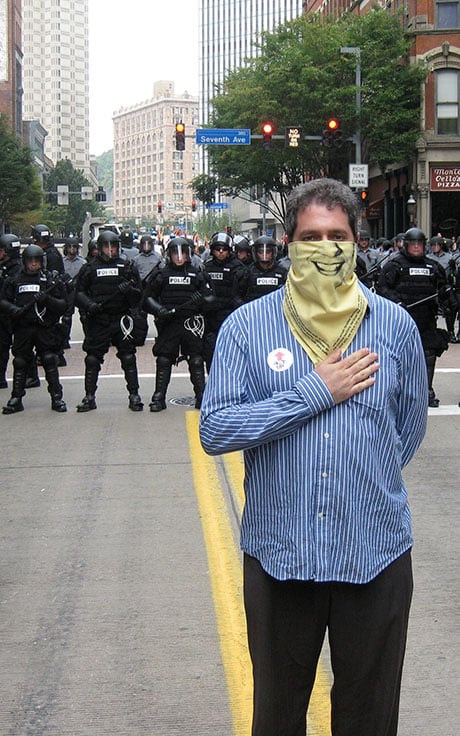 Bogad at the G-20 protest in Pittsburgh, 2012. (Credit: Gary Huck)Now, Bogad has released Tactical Performance: The Theory and Practice of Serious Play, a complete how-to guide and comprehensive study of creative nonviolence, pranksterism, subvertisement and cultural sabotage for activists, performers and anyone who is ready to take the streets. He also recently released a second edition of his landmark Electoral Guerrilla Theatre: Radical Ridicule and Social Movements, which explains how to run for office as a gnome and actually get elected.
Bogad at the G-20 protest in Pittsburgh, 2012. (Credit: Gary Huck)Now, Bogad has released Tactical Performance: The Theory and Practice of Serious Play, a complete how-to guide and comprehensive study of creative nonviolence, pranksterism, subvertisement and cultural sabotage for activists, performers and anyone who is ready to take the streets. He also recently released a second edition of his landmark Electoral Guerrilla Theatre: Radical Ridicule and Social Movements, which explains how to run for office as a gnome and actually get elected.
Here Bogad discusses the role of theater in protest, how the Civil Rights Movement used “tactical performance” and his role in some of the most unforgettable street theater.
Lorna Garano: You’ve appeared on picket lines in roles such as Ronald McDonald, Saint Francis, Sam Walton and an Angry Banker. Why do you think picket lines are such important “play spaces” for serious play and dramatization?
L.M. Bogad: Picket lines are one of those key, everyday points of confrontation in protest. There’s something real and important at stake — will people cross the picket line? Will the strike or boycott succeed? But a lot of the time this space is haunted by cliché and is too easily ignored. We march in circles with signs repeating the same chants over and over — and it’s a good cause, but it’s bad theater. People ignore you, or resent you, too easily.
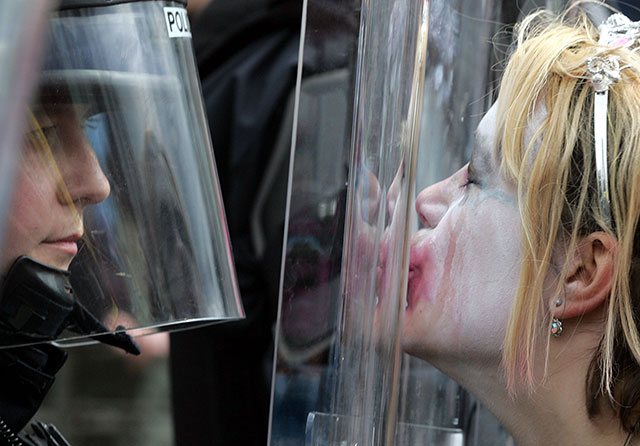 The Clown Army, of which Bogad was a cofounder, in action creating an “irresistible image” at the G-8 protests in Edinburgh, 2005. (Credit: Peter Morison)
The Clown Army, of which Bogad was a cofounder, in action creating an “irresistible image” at the G-8 protests in Edinburgh, 2005. (Credit: Peter Morison)
If we can get creative on the picket line, we can attract a crowd and win their support, or at least tell our story in a compelling, charismatic way to the media and passersby.
This is something I focus on when doing workshops with unions and other action groups. Protest is an art form, a performance. If you don’t think of it that way you just end up doing a bad performance. So if we can get creative on the picket line, we can attract a crowd and win their support, or at least tell our story in a compelling, charismatic way to the media and passersby. It’s also more entertaining for our own “troops” when the picket line action is clever and fun and participatory, so that makes the whole thing less tedious and exhausting and more sustainable.
So yes, as “Saint Francis” I joined the hotel workers who were locked out of the St. Francis hotel and we turned the picket line into an “exorcism of the demons of greed from the hotel.” We brought in Father Louis Vitale, an actual radical Franciscan monk, to join in on the fun, and he was amazing. We all had a great time and eventually the hotel gave in — though of course not just because of our “divine intervention.”
The Angry Banker was another fun one — you can see that here.
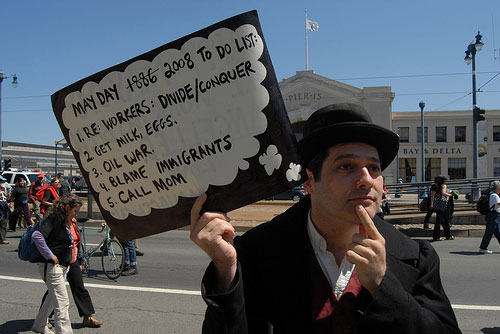 MayDay protests, San Francisco, 2008. (Credit: Xago Juarez)That was for the blockade of Wells Fargo’s global HQ in San Francisco in protest of their local policies re: avoiding taxes in Oakland, turning down small business loans and evicting and foreclosing mercilessly in the wake of the bank-induced collapse and recession… The picket line is one of those great opportunities to tell our side of the story.
MayDay protests, San Francisco, 2008. (Credit: Xago Juarez)That was for the blockade of Wells Fargo’s global HQ in San Francisco in protest of their local policies re: avoiding taxes in Oakland, turning down small business loans and evicting and foreclosing mercilessly in the wake of the bank-induced collapse and recession… The picket line is one of those great opportunities to tell our side of the story.
You say that tactical performance is a “political crowbar or force multiplier” for movements. What do you mean? How can the skill sets and “rules” of theatre inform better creative activism?
Some of the skill sets of theatre can really help with this — thinking in terms of tension, surprise, symbolism, timing, “earning a moment” to make your point with a strong image, as well as obvious aspects like costuming, acoustics, sight lines, etc.
I think often our social movements — for human or civil rights, ecological/economic justice, etc., are resource-poor in comparison with our opponents — major corporations, governments, et al. Tactical performance — guerrilla theatre, creative and sociodramatic action, symbolic culture jamming, media pranks, etc — are relatively low-cost and medium-to-low-tech. But when deftly used, they can amplify the voice of the movement, acting like a political crowbar to leverage much greater pressure than would otherwise be possible.
I like to think of it as finding pressure points on the body politic the same way someone trained in aikido tries to find pressure points on the body of the opponent to move them around with minimal force and maximum effect. I share a lot of examples of this in the book and in talks/workshops, trying to learn from our history.
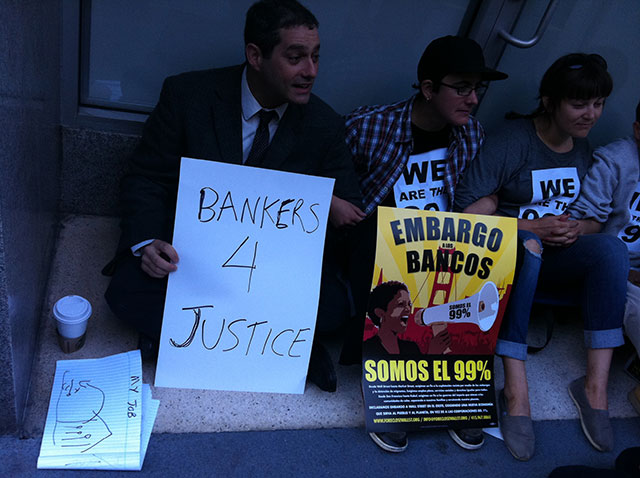 The Banker joins the blockade. (Credit: Jeff Conant)
The Banker joins the blockade. (Credit: Jeff Conant)
One criticism that is often leveled at political pranksterism is that it trivializes serious issues. What do you say to this?
I think sometimes you have to take a situation seriously enough to make fun of it. Satire and pranks have been a vital aspect of democratic dissent going all the way back to before there was democracy. And freedom is a use it or lose it proposition — better to use those freedoms to make satire while you still can. At the same time, satire or parody are not always the right tool for the right job. The whole emotional palate should be considered. Some of the best tactical performances are reverent, somber, haunting.
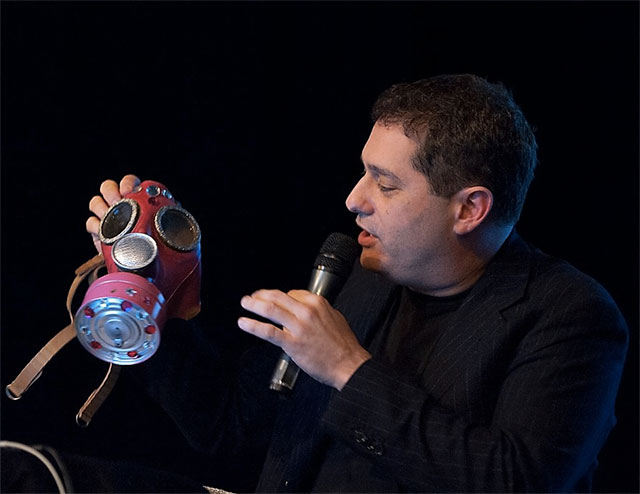 Bogad explaining the bejazzled gas mask, a key costume piece for creative protest, at a keynote talk in Helsinki, 2012. (Credit: Antti Yrjönen)
Bogad explaining the bejazzled gas mask, a key costume piece for creative protest, at a keynote talk in Helsinki, 2012. (Credit: Antti Yrjönen)
In the game of political protest, why do progressive activists often behave like amnesiac chess players?
Very often our movements repeat the same mistakes because we don’t have the same kind of built-in institutional memory that, say, corporations or states have. But we can build up that counter-institutional memory and many activists have worked really hard to do that — to remember good tactics and also to remember and learn from the mistakes we’ve made. I was doing a workshop with eco-activists in Iceland years ago, and we had a great time moving from their initial radical anger-aesthetic (effigy hanging, politicians’ face-dartboards, etc.) to more playful and surprising moves… I recently worked with artist-activists in Latvia and they did wonderful work connecting to old symbolism — local monuments, folktales and flipping the script, reworking those old statues and tales to serve creative actions for gender equality and against xenophobia.
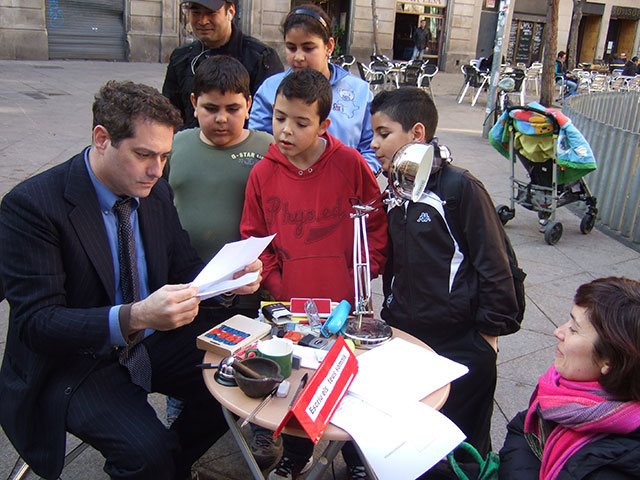 Bogad performs as the “Ministry of Dreams, Hopes, and Fears” in George Orwell Square in Barcelona in a creative protest against the government’s Orwellian anti-protest law. (Credit: Ramon Gabarrós)
Bogad performs as the “Ministry of Dreams, Hopes, and Fears” in George Orwell Square in Barcelona in a creative protest against the government’s Orwellian anti-protest law. (Credit: Ramon Gabarrós)
In Tactical Performance you describe the use of “sociodrama” and “creative suffering” in the Civil Rights Movement and how events like the lunch counter sit-ins were rehearsed and scripted performances. Can you tell us more about this?
I go into it more deeply in the book, but essentially the sit-ins were a masterful example of “sociodrama” and “creative suffering” — terms the movement used to theorize its own actions. They rehearsed the sit-ins to achieve maximum emotional effect on the global and national audience through tight discipline over their own emotions. Their opponent had all the legal rights, all the deadly weaponry, all those obvious advantages, but that made them arrogant and therefore predictable. The movement brilliantly and bravely used these highly dramatic actions, and their opponents’ predictability, to create sociodramas where they cast their powerful opponents as the vile antagonists for all the world to see. This helped to leverage intervention to break up the apartheid state. They rehearsed relentlessly, and had staging, bearing, costume and script in mind. When the other side reacted automatically, violently and hatefully, it was their cause that suffered.
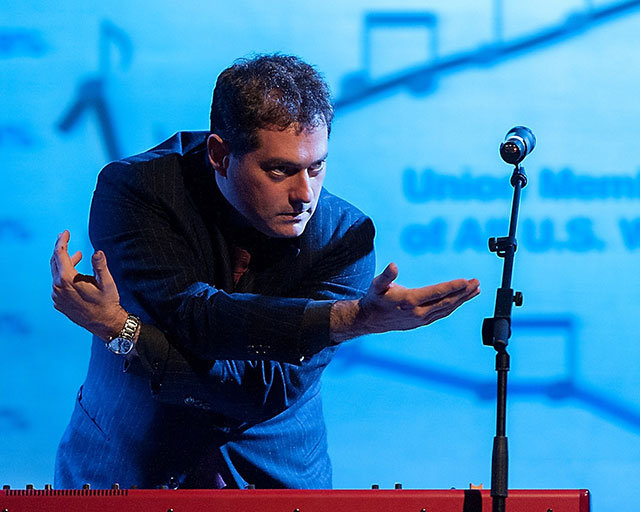 Bogad as the Economusician, performing economic data as music, his arms twisted by the piano score of Inequality. Helsinki, 2012. (Credit: Antti Yrjönen)
Bogad as the Economusician, performing economic data as music, his arms twisted by the piano score of Inequality. Helsinki, 2012. (Credit: Antti Yrjönen)
Activist George Lakey coined the term “dilemma demonstration” to describe a public action that puts authorities in a situation in which they have no good move to make. Give us an example.
This is a key idea. I’ll give an example. We created an army of clowns (Colonel Oftruth, reporting for duty!) that would join demonstrations. If the police smashed us up, the image on TV and on the internet of police roughing up clowns would be very expensive politically. Especially since our antics were ridiculous but playful, even when we blocked the street or a highway, etc.
But I think the best and more serious example of this would be the sit-ins described above. They put the white power structure into a decision dilemma for sure. This is a technique used by dissident movements all over the world.
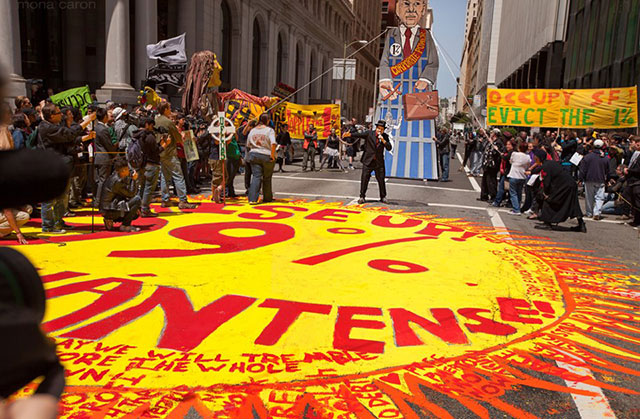 Bogad as the 1% at a theatrical protest in San Francisco, where all the protesters painted the stage on the street and performed on it together, 2012. (Credit: Mona Caron)
Bogad as the 1% at a theatrical protest in San Francisco, where all the protesters painted the stage on the street and performed on it together, 2012. (Credit: Mona Caron)
Fearing The New York Times might sue your group for creating a parody, “special edition” of the Times, with all the news you wished would come true in the world, your creative team came up with a very clever name for the entity distributing the papers. What was your group named?
I wish this was my idea. But the LLC that collected the donations was called “The Spirit of Free Speech in America.” So if they’d sued, the name of the case, for the media coverage, for the legal history books, for all posterity, would have been The New York Times vs. the Spirit of Free Speech in America. I don’t know if that influenced the Times’ decision not to sue, but anyway the larger idea is to anticipate your opponents’ reactions and incorporate that into your own plan.
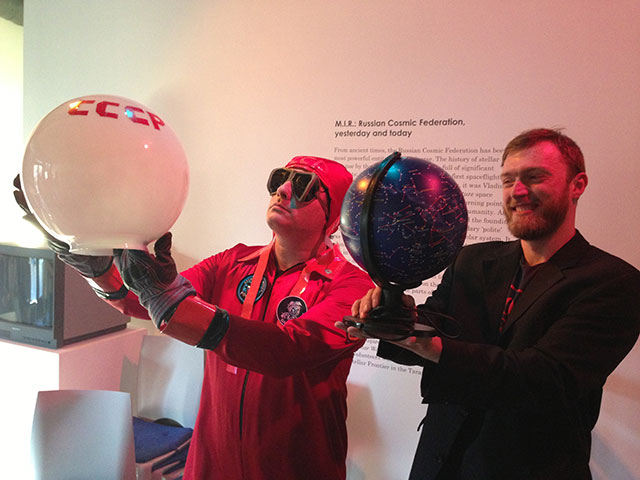 Bogad as cosmonaut collaborates with dissident Russian artist Arseniy Zhilayev, 2014. (Credit: Ballitronica)
Bogad as cosmonaut collaborates with dissident Russian artist Arseniy Zhilayev, 2014. (Credit: Ballitronica)
Tell us about the guerrilla musical “Public Option Annie” and how it landed the fight for Universal Health Care on CNN. On the other hand, what is the downside of overemphasizing obtaining media coverage of an action?
It was a fun and surprising action, involving infiltrating the big corporate health care meeting where they were planning how to block Obamacare, and busting out into a full-throated satirical song advocating for the public option. Here’s a link to that one, including the coverage on MSNBC. Wolf Blitzer also covered it on CNN.
But, it’s not only about media coverage. The important work of any movement is the day to day organizing at the grassroots level. If we lose sight of that, we end up disconnected from real organizations and progress. On the other hand, as an important complementary side of movement activity, this kind of media spectacle can help soften up the cultural ground so that the movement can make more advances. The cultural side of the struggle is not more important, but it is necessary, too.
What are some other ways law enforcement restricts peaceful political protest in this country, and what are creative ways to react to those restrictions?
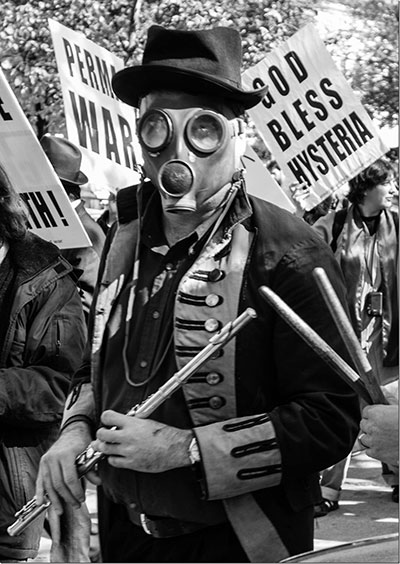 Bogad as the Spirit of ’76 Gone Wrong. (Credit: Fred Askew)There are so many techniques — from arbitrary and selectively enforced laws against wearing masks to militarized mega-policing to infiltration and agent provocateurs… but there’s usually some creative way to outflank, at least partially, these restrictions. We’re talking about tactical interaction here — we think up a surprising move, it lasts for a while and is fun and surprising, then the state finds a tactic to end it… then we have to think up a new creative tactic. I tell some stories of this kind of cat-and-mouse game in the book, but the bottom line is movements have to stay agile, flexible and creative. And strong performance chops can help with that.
Bogad as the Spirit of ’76 Gone Wrong. (Credit: Fred Askew)There are so many techniques — from arbitrary and selectively enforced laws against wearing masks to militarized mega-policing to infiltration and agent provocateurs… but there’s usually some creative way to outflank, at least partially, these restrictions. We’re talking about tactical interaction here — we think up a surprising move, it lasts for a while and is fun and surprising, then the state finds a tactic to end it… then we have to think up a new creative tactic. I tell some stories of this kind of cat-and-mouse game in the book, but the bottom line is movements have to stay agile, flexible and creative. And strong performance chops can help with that.
What is your next outlandish performance?
Big street extravaganza in Oakland in June – riding in a pink limo with other performer-activists — here’s the link to that. Audience members will be asked to show up as the space-oligarchs of the future — sort of Trump’s great grandchildren coming down to Earth from the Trump Nebula. The Borgia-Rockefellers of the galaxy. I did this in San Francisco, and people showed up in outrageous costumes, and now we’re doing it in Oakland. I help them get in character with some speeches and toasts and an original card game, which they play against each other as the limo drives around the city, but there are a few revolutionary surprises for them along the way.
5 Days Left: All gifts to Truthout now matched!
From now until the end of the year, all donations to Truthout will be matched dollar for dollar up to $50,000! Thanks to a generous supporter, your one-time gift today will be matched immediately. As well, your monthly donation will be matched for the whole first year, doubling your impact.
We have just 5 days left to raise $50,000 and receive the full match.
This matching gift comes at a critical time. As Trump attempts to silence dissenting voices and oppositional nonprofits, reader support is our best defense against the right-wing agenda.
Help Truthout confront Trump’s fascism in 2026, and have your donation matched now!